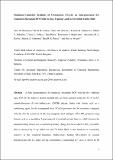Modulator-controlled synthesis of microporous STA-26, an interpenetrated 8,3-connected zirconium MOF with the the-i topology, and its reversible lattice shift
Abstract
A fully interpenetrated 8,3-connected zirconium MOF with the the-i topology type, STA-26 (St Andrews porous material-26), has been prepared using the 4,4',4"-(2,4,6-trimethylbenzene-1,3,5-triyl)tribenzoate (TMTB) tritopic linker with formic acid as a modulating agent. In the as-prepared form STA-26 possesses Im-3m symmetry compared with the Pm-3m symmetry of the non-interpenetrated analogue, NU-1200, prepared using benzoic acid as a modulator. Upon removal of residual solvent there is a shift between the interpenetrating lattices and a resultant symmetry change to Cmcm which is fully reversible. This is observed by X-ray diffraction and 13C MAS NMR is also found to be remarkably sensitive to the structural transition. Furthermore, heating STA-26(Zr) in vacuum dehydroxylates the Zr6 nodes leaving coordinatively unsaturated Zr4+ sites, as shown by IR spectroscopy using CO and CD3CN as probe molecules. Nitrogen adsorption at 77 K together with grand canonical Monte Carlo simulations confirms a microporous, fully interpenetrated, structure with pore volume 0.53 cm3 g−1 while CO2 adsorption at 196 K reaches 300 cm3 STP g−1 at 1 bar. While the pore volume is smaller than that of its non-interpenetrated mesoporous analogue, interpenetration makes the structure more stable to moisture adsorption and introduces shape selectivity in adsorption.
Citation
Bumstead , A , Cordes , D B , Dawson , D M , Chakarova , K K , Mihaylov , M Y , Hobday , C L , Düren , T , Hadjiivanov , K , Slawin , A M Z , Ashbrook , S E , Prasad , R R R & Wright , P A 2018 , ' Modulator-controlled synthesis of microporous STA-26, an interpenetrated 8,3-connected zirconium MOF with the the-i topology, and its reversible lattice shift ' , Chemistry - A European Journal , vol. Early View . https://doi.org/10.1002/chem.201705136
Publication
Chemistry - A European Journal
Status
Peer reviewed
ISSN
0947-6539Type
Journal article
Description
The authors acknowledge the support of the EPSRC/St Andrews Criticat CDT (RRRP, PAW) and the European Community Seventh Framework Program (FP7/2007-2013) number 608490 (project M4CO2) (KKC, MYM, KIH, PAW). SEA would like to thank the Royal Society and Wolfson Foundation for a merit award. This research made use of the Balena High Performance Computing (HPC) Service at the University of Bath. The research data (and/or materials) supporting this publication can be accessed at DOI: http://dx.doi.org/10.17630/6ffeed8a-e75f-4648-968f-3ed32a94e9a0.Collections
Items in the St Andrews Research Repository are protected by copyright, with all rights reserved, unless otherwise indicated.

